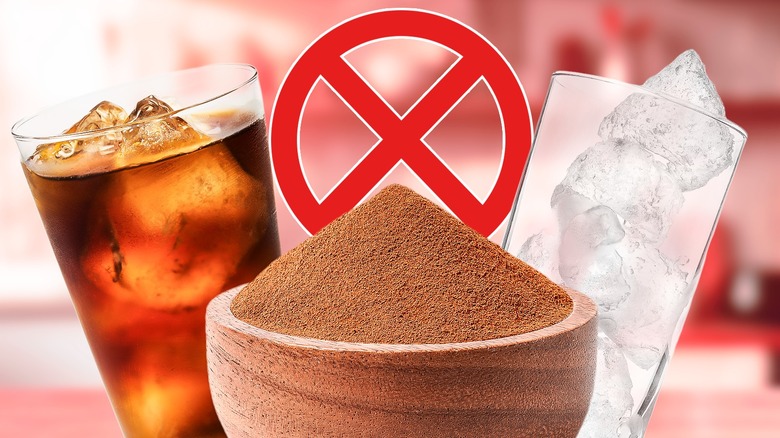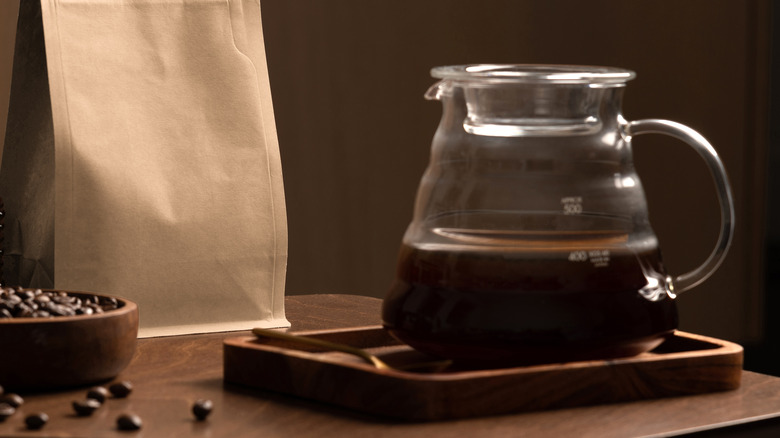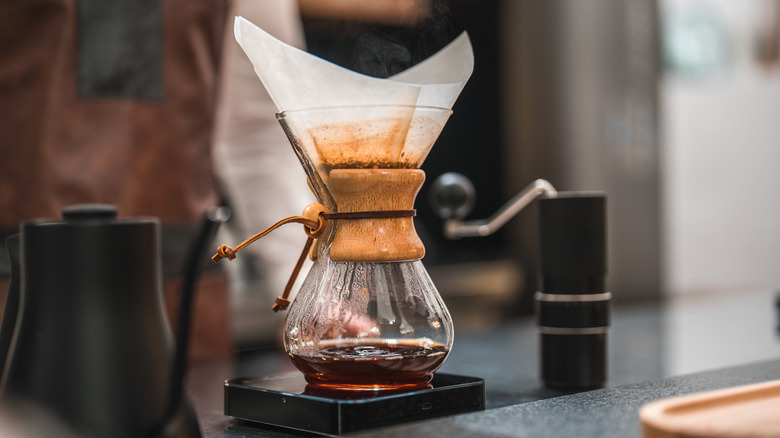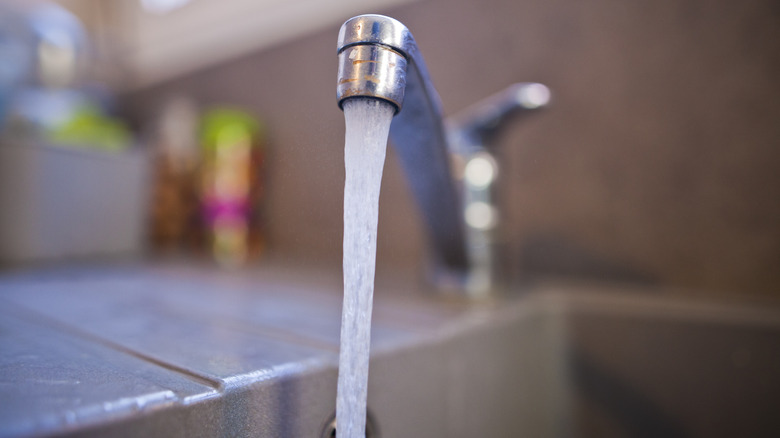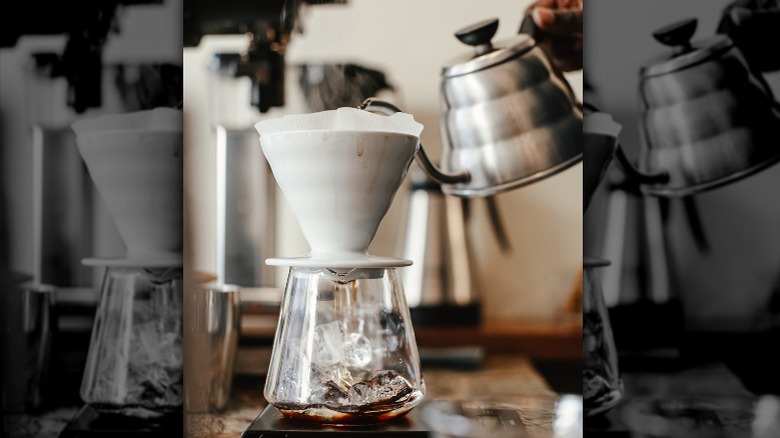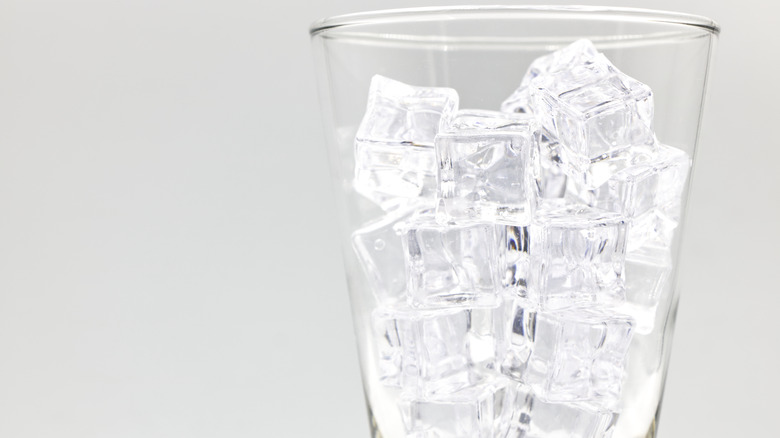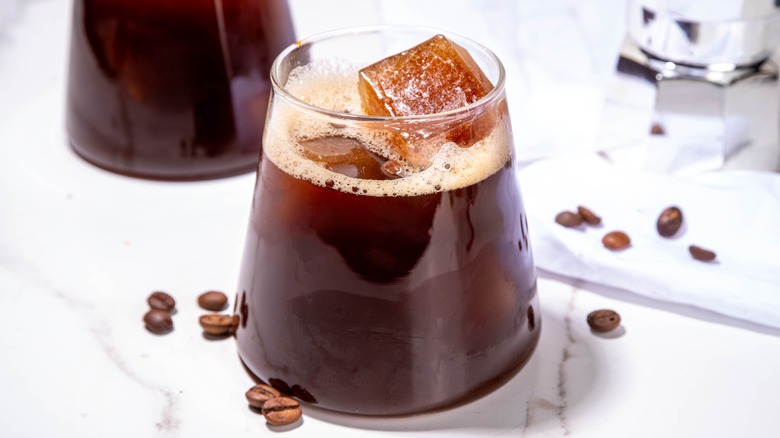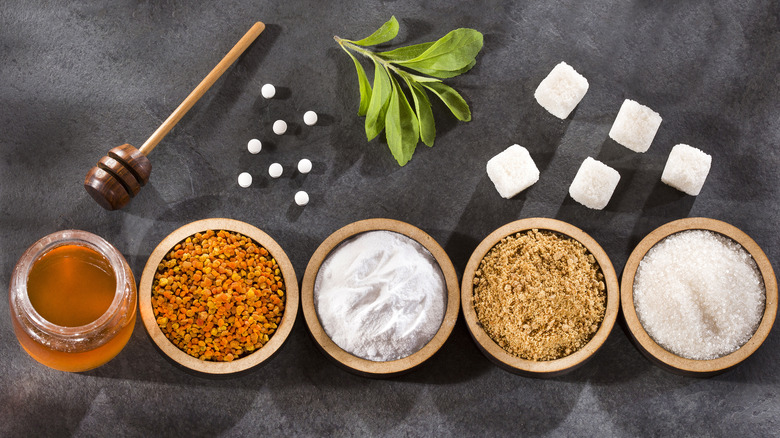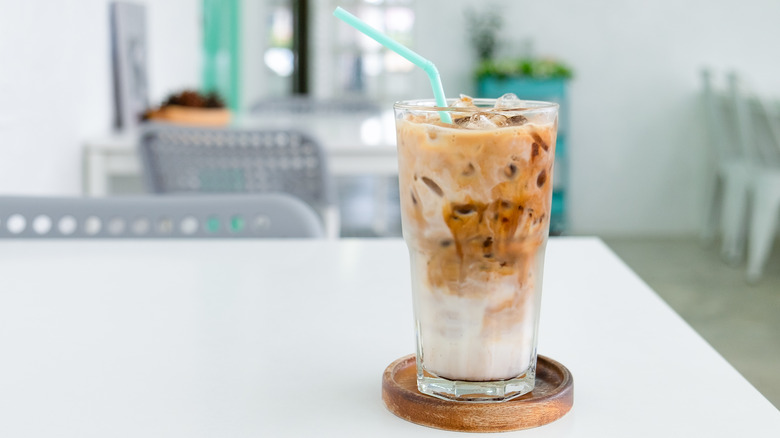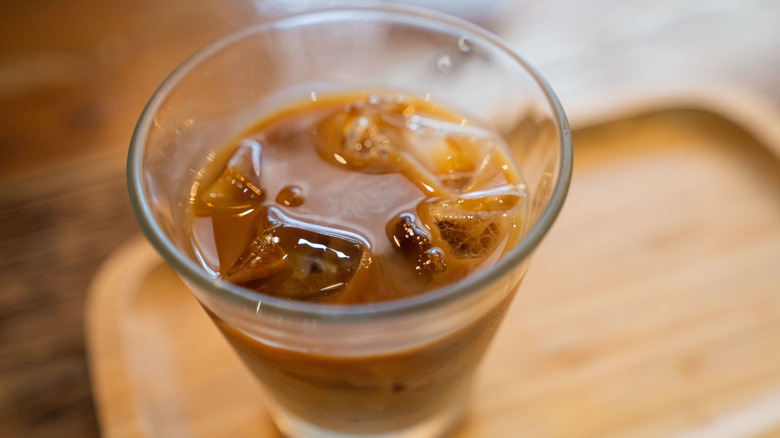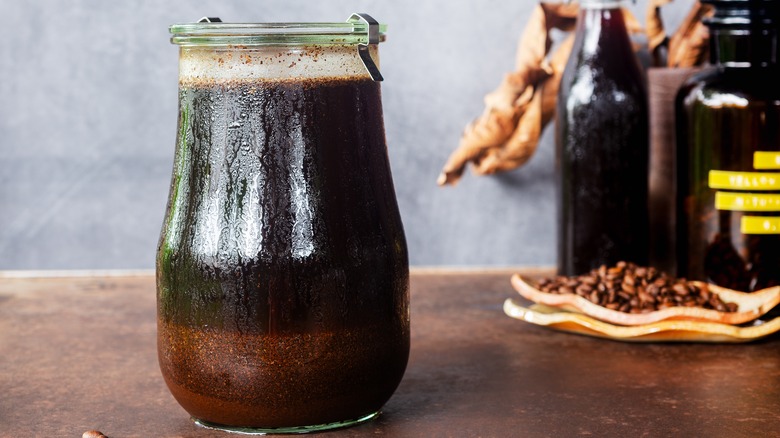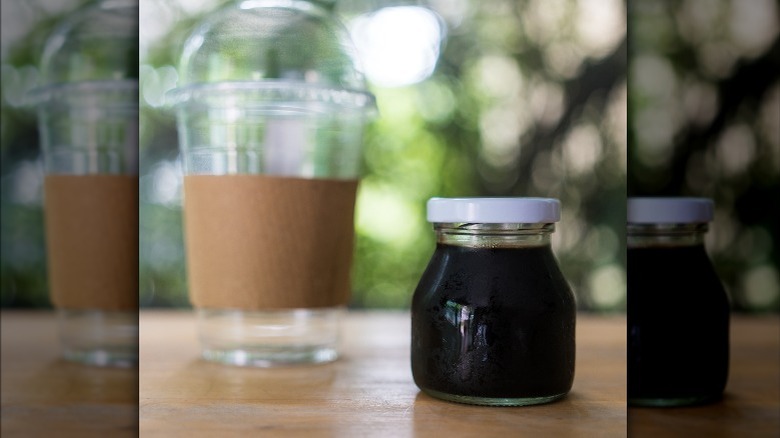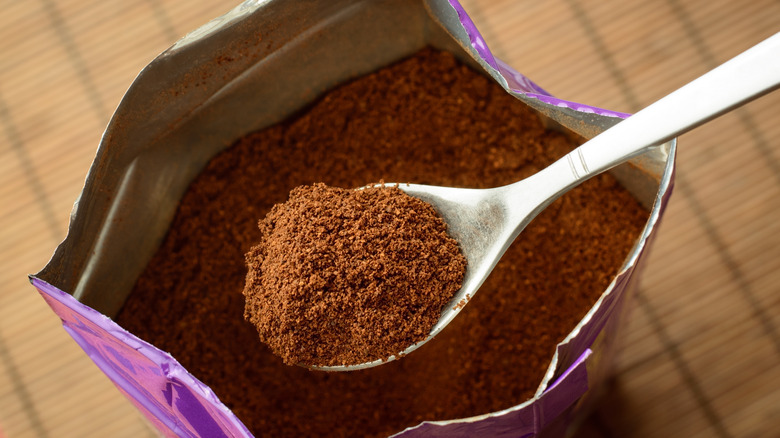13 Mistakes You're Making With Iced Coffee
Before there was cold brew coffee, there was iced coffee. The styles are different, and the terms shouldn't be used interchangeably, yet it's a common mistake people make. The main difference is in the initial preparation. After it's made, cold brew coffee can become a delicious iced coffee, but iced coffee is not typically made from cold brew. Making iced coffee may seem like a simple task of tossing some ice cubes into a cup of cold coffee, but we can assure you it's not. Like most coffee creations, there's a little bit of skill, science, and art to making a stellar iced coffee.
As someone who has made thousands of iced coffees over the years, I learned the various tips and tricks of the trade by way of trial and error before being taught by professional coffee experts. The perfect iced coffee is refreshingly cold but doesn't elicit a brain freeze. The coffee itself is smooth, your desired additions are well balanced, and the amount of ice you use doesn't dilute the coffee's taste. Plus, the ice melts at roughly the same pace as you drink your iced coffee. Even so, I consulted with Patti Tushim, head of research and development at Coffee Beanery, to glean professional tips for making a perfectly brewed iced coffee.
1. Using leftover coffee
We've all been there — you make a giant pot of coffee that, for one reason or another, doesn't get finished. And rather than dump it down the sink, you contemplate drinking it as iced coffee at some point. There's nothing wrong with that (I do it all the time), but it would be a mistake to think this is the optimal way to enjoy an iced coffee. Leftover coffee that hangs around past its shelf life tends to have a stale or bitter taste, and it may even come across as burnt if the carafe was sitting on the heating element for too long.
But before you begrudgingly pour your days-old coffee down the drain, consider using it to make a refreshing blended caffeinated treat or as an additional ingredient in a decadent dessert that could turn out better with coffee. Should your leftover coffee have an off taste, other ingredients like chocolate, rye, or cinnamon can help hide the somewhat unpleasant flavor and enhance the coffee instead. To keep it as fresh as possible, one of the easiest ways to make iced coffee is to brew your coffee the night before the day you want to enjoy it. Or, as Patti Tushim tells us, "Brew a larger pot of coffee in the morning." After you enjoy a fresh cup of hot coffee, "turn the burner off and let the coffee come to room temperature for an iced coffee in the afternoon."
2. Brewing a light roast coffee bean
Even if you enjoy a light roasted coffee when it's hot and steamy, a good iced coffee requires a bean that's a little darker and richer. Iced coffee isn't as strong as hot coffee, and if you brew a light roasted bean for your iced option, you may be disappointed in the flavor you get — or don't get. While your light roasted hot coffee may have a deep enough taste for you, hot coffee loses acidity as it cools, giving it a lighter, more subtle, and sweeter flavor. Iced coffee also naturally becomes more diluted as the ice melts, and you're using fewer senses since the steamy aroma of hot coffee is not hitting your nose. This is why the best roast to use for iced coffee is a medium to dark roast.
Patti Tushim tested this theory and ran her own personal experiments. She tells us, "[I] found I preferred our dark roasts for cold brew and iced coffee." Incidentally, brewing coffee hot extracts more from the beans than cold brewing, which is why cold brew also benefits from using a medium to dark roast coffee bean. Tushim says, "There's something about that dark and earthy with chocolatey undertones that is just chef's kiss in an iced coffee for me. My favorites are our French Roast and our Italian Roast."
3. Not brewing your coffee strong enough
Iced coffee doesn't pack as much of a punch as hot coffee. A steaming cup of joe is still full of the acidic undertones that bite your tongue and linger at the back of your throat. But as coffee cools, it loses this front-and-center sensation, so your iced coffee is far more mellow. For this reason, when you brew your coffee fresh for iced, brew it just a little stronger than you would normally drink it black (or with cream and sugar, we're not judging). Choose a coffee brand that's best when drinking it black, and your iced coffee will have a delicious base to work with.
But if you have found that you didn't brew your coffee strong enough, don't despair — an easy way to boost both the flavor and caffeine content of your iced coffee is to add an espresso shot — otherwise known as the red eye (a personal favorite). Simply add a shot of espresso over ice and then pour in your cold coffee. Of course, the strength of your coffee is a matter of personal preference.
4. Using tap water
The water you use may not be the first thing you think of when making coffee, but it's a vital part of the caffeinated equation. Though tap water has its place, that place is nowhere near your coffee or coffee machine. Tap water is treated and regulated by the EPA because of the risk of high amounts of contaminants and microorganisms that could potentially make you sick. Depending on where you live, tap water is typically treated with chlorine or chloramine and is either soft or hard. Hard water leaves calcium deposits behind, which could clog and damage your coffee machine. Though it may be perfectly safe for you to drink, these factors could add an underlying and undesirable taste to your coffee.
Patti Tushim recommends filtered water to make your iced coffee. Filtered water is just an additional method of removing unwanted particles and contaminants from your tap water. Filtering your water can remove harsher substances like the chlorine used to treat your tap water, as well as any sediment that might not get filtered out of your faucet. But filtered water doesn't just make your coffee taste better, it's gentler on your coffee machine and will help it to last longer.
5. Pouring hot brewed coffee over ice
When iced coffee machines first hit the shelves, the concept was simple: brew strong hot coffee over ice. But it still meant brewing hot coffee and hoping the ice would chill it enough to enjoy an iced coffee immediately. Personally, I've never found this to be the case. Patti Tushim thinks this method is the No. 1 mistake people make when making iced coffee. We agree. "It just melts the ice and waters it down," she says. But if you really want to use this method, Tushim suggests making coffee ice cubes so at least "when the hot coffee is brewed over the ice, it won't water it down."
Most iced coffee machines will give you explicit directions on the ratio of hot coffee to ice cubes, but in order for it not to be watered down, you may need to play around with those ratios. That could mean a lot of wasted coffee and ice. Your best bet, according to Tushim, is to "cool your coffee down completely and then pour it over ice."
6. Not adding the right amount of ice
Have you ever ordered an iced coffee from a coffee shop and the barista filled your cup to the top with ice cubes, then added the coffee? You wound up taking three sips from your straw and you were done with your iced coffee, only to be left with a cup full of ice. Sure, the coffee was nice and cold, but that amount of ice is overkill. Patti Tushim recommends filling your cup only about halfway with ice.
When you're making iced coffee at home, you can try various amounts of ice cubes to find what's optimal for you. Your favorite iced coffee tumbler or mug may be suited for a certain number of ice cubes. Or maybe you're someone who drinks your iced coffee so fast, a couple of cubes will do you just fine. But unless you want very little coffee, a diluted coffee, or aren't looking to add any other ingredients, don't go crazy with the ice.
7. Using the wrong kind of ice
If you haven't thought too much about your ice before, now is the time. This is called iced coffee, after all, and not just any old type of ice will do. Maybe you're used to pressing your cup against the tab on your fridge ice maker and settling for whatever pops out. This could work, depending on the size and shape of your fridge's ice. It may also work if the water in your ice maker is filtered, and the filter has been changed recently. Or maybe you're old-school and still fill ice cube trays with water from your tap.
Choosing the right ice to go with your cold coffee is important if you want the best iced coffee you can make. Crushed or shaved ice may make your iced coffee look fancy, but that shape of ice will melt much faster and water down your coffee quickly. Cubes are preferred. And cubes from filtered water are the recommended choice for making iced coffee. But you don't need to stick to just filtered water for ice cubes. Patti Tushim explained that her favorite way to add coldness to her coffee is by using ice cubes made from coffee. This way, her coffee stays cold and doesn't get watered down as the cubes melt. A secret for making ice coffee cubes: use instant coffee. Or trying freezing cubes of milk, cream, or your favorite creamer.
8. Using the wrong type of sweetener
These days, there's a wide range of sweeteners on the market to choose from, and you probably have your favorite. But when it comes to cooking or baking — or making iced coffee — there are dos and don'ts as to which type of sweetener to use. If you opt for a granulated sugar — even if it's in the purest form because you heard it was the better option — you'd be making a mistake making your iced coffee. Granulated sugar just doesn't melt in cold coffee. A quick tip if you're dead set on using granulated sugar: melt it in a small amount of warm coffee to dissolve it before adding it to your iced coffee.
The best type of sweetener to add to iced coffee is a liquid sweetener. This way, it blends more easily with cold coffee so you're not choking on sugar bits at the bottom of your cup. Patti Tushim tells us, "I prefer cane sugar liquid sweetener (Monin makes a great one), flavored syrups, or making my own simple syrup if I have time." Simple syrup is both basic and brilliant. You can also opt for liquid honey or maple syrup to add a little flavored sweetness to your iced coffee.
9. Adding ingredients in the wrong order
The two main elements of iced coffee are (get this) ice and coffee. Most like to add other ingredients, like creamer (be it milk, cream, or a substitute variation), sweetener, and flavoring. How you add each of these components can change your iced coffee. Likewise, the order in which you add these elements can depend on what you're putting in your iced coffee. For instance, an American-made iced macchiato requires the specific order of milk, ice, and then espresso to achieve a marbled effect, while a traditional iced latte is typically espresso poured over ice first, and then milk is added for a topping effect. This simple variation in order changes your iced coffee experience.
As far as making a classic iced coffee, most folks add ice first, and Patti Tushim agrees. "I always add ice to the cup first to prevent any sloshing over," she says, "followed by sweetened creamer, cold coffee, and cold foam or whipped cream if I'm feeling fancy." Alternatively, I learned to add ice last so all of my ingredients blend well without the ice hindering the process. Also, so certain ingredients, like cinnamon or cacao powder, don't inadvertently stick to the cubes before mixing the coffee.
10. Letting your iced coffee sit too long
Maybe this isn't an issue for most people, but letting your iced coffee sit around for too long just means that the ice will melt too much, ruining your perfectly made coffee before you get a chance to enjoy it. Of course, this doesn't mean you need to gulp down your iced coffee. If you think you're going to be delayed from drinking your crafted cup (especially if you have kids), wait to add the ice (another good reason to add ice last). You can then pop your cold coffee in the fridge to keep it chilled while you go about your business. Then just add ice when you're ready to actually drink it.
No one wants an iced coffee that has a layer of water sitting on the top. Already added the ice but then got called away? Scoop out your ice to keep it from melting further. Stir your iced coffee well and keep it cold. When you're ready to get back to your iced coffee, add a little more coffee or creamer to liven it up and then add fresh ice. Or to avoid this all together, use Patti Tushim's trick of coffee ice cubes. When they melt, they'll simply add more cold coffee to your drink.
11. Not taking advantage of cold brew
Cold brew requires brewing coffee with cold water, whereas iced coffee typically means brewing coffee with hot water and then using the coffee when it has cooled. But why not enjoy the best of both coffee methods? Use cold brew coffee as the base for your iced coffee creation. "I love making a good cold brew," Patti Tushim tells us. "Yes, it takes time, but it yields a nice coffee concentrate that can last for a week in your fridge (if you don't drink it first)." Then just use your cold brew coffee concoction to create your desired iced coffee as you normally would.
The cold brew base is a simple procedure — it just takes time and patience. Tushim explains, "I make mine with ¼ cup of coarsely ground coffee and 1-½ cups of cold, filtered water." She places the coffee in a filter bag and puts that in a mason jar. "I pour the water over the coffee and let it steep in my fridge for 12 hours," she says. "Once it's brewed, I mix one part concentrate to one part milk or water. It's perfect and smooth." Once you've made your cold brew, follow the procedure for making iced coffee using this instead of hot brewed coffee.
12. Storing cold coffee incorrectly
There's nothing worse than taking the time to make a perfectly brewed hot or cold coffee and then storing it incorrectly so it's not even drinkable. How long you can store your brewed coffee depends on how you made it and what you store it in. Hot brewed coffee won't last as long as cold brew, and cold brew concentrate will last the longest. This is because the lack of heat used to make the coffee results in less oxidation and lower acidity levels. No matter which type of coffee you have brewed, an air-tight, glass container is your optimal choice for a long fridge life — up to seven days, according to Patti Tushim. You can also freeze it.
To determine if your refrigerated coffee is past the point of enjoyment, use your eyes, nose, and taste buds. Be sure there's no mold, that it still smells like good coffee, and it doesn't taste too acidic or off-putting.
13. Not experimenting with flavored coffees
Making iced coffee can expand beyond your typical roasted bean, such as French roast or Colombian. One of the easiest ways to upgrade your iced coffee is to use a flavored coffee, Patti Tushim suggests. Make your iced coffee in the same way as if you were brewing a classic roast but use a flavored variety instead. It's a simple way to create a tasty iced coffee without adding a lot of other ingredients. With a plethora of flavors to choose from, like chocolate raspberry, vanilla macadamia nut, hazelnut, buttered rum, and dark chocolate almond, your options are practically endless for making a custom iced coffee that fits your personal preferences.
Once you've chosen your flavored coffee base, get creative with additional ingredients to further enhance your iced coffee. For instance, add cinnamon and maple syrup to a blueberry flavored coffee or cacao powder or chocolate syrup to a hazelnut flavored coffee.
